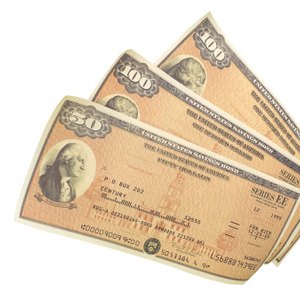
The U.S. government created savings bonds to encourage individuals to participate in government finance. The U.S. Department of the Treasury issues savings bonds, which are federal government debt instruments. Like other obligations of the federal government, such as treasury bills and treasury bonds, the U.S. government backs U.S. savings bonds with its full faith and credit. Unlike some other treasury-issued securities, U.S. savings bonds are non-marketable securities, which cannot lose their value.
Read More: Can Savings Bonds be Reinvested?
Series EE Savings Bonds
Series EE savings bonds are the successors to Series E savings bonds, which are no longer issued by the U.S. Treasury. Series EE savings bonds are available in electronic and paper versions. Purchasers buy electronic EE savings bonds at their face value and redeem them at their face value plus interest.
The government sells paper EE savings bonds at 50 percent of their face value; they mature at their full face value. All issues of EE savings bonds pay interest for 30 years. All issues of EE savings bonds cease paying interest once they have matured.
Read More: Value of United States EE Savings Bonds
Series I Savings Bonds
Series I savings bonds may be purchased in either electronic or paper form. Both electronic and paper versions of Series I savings bonds are purchased at face value and earn interest until they are redeemed or reach maturity. You must hold Series I bonds for at least 12 months before redeeming them.
Series I savings bonds will continue to earn interest for up to 30 years. They will cease paying interest once they have matured.
Series H and HH Bonds
The U.S. treasury ceased issuing Series H and Series HH savings bonds, as of September 2004. Series H and Series HH savings bonds paid current income interest for each six-month period the bonds where held. The rate of interest and the maturity of these bonds varied based on the date of initial issue.
Series H savings bonds that were issued through January 1957 ceased paying interest after 29 years and eight months. Series H savings bonds issued between February 1957 and December 1979 ceased paying interest after 30 years. Series HH bonds issued through August 2004 will cease paying interest after 20 years.
Considerations Before Investing
U.S. savings bonds are among the safest of all investments because the U.S. Government backs them. The interest earned on U.S. savings bonds is free from state and local income taxes. Bondholders may defer paying taxes on the interest earned on U.S. savings bonds until redemption. The government registers both electronic and paper versions of U.S. savings bonds in the bondholder's name, for replacement purposes if they are lost or stolen.
In addition, savings bond interest rates were adjusted in 2021 and will continue to be adjusted every several months. This is an incentive for those looking to buy bonds with better interest rates than the current CD rates. Considering investing during the incentive months could give you a better return on your money if you have 30 years (in some cases) to wait.
Read More: How to Find Out How Much a Savings Bond is Worth?
References
Writer Bio
Mike Parker is a full-time writer, publisher and independent businessman. His background includes a career as an investments broker with such NYSE member firms as Edward Jones & Company, AG Edwards & Sons and Dean Witter. He helped launch DiscoverCard as one of the company's first merchant sales reps.

